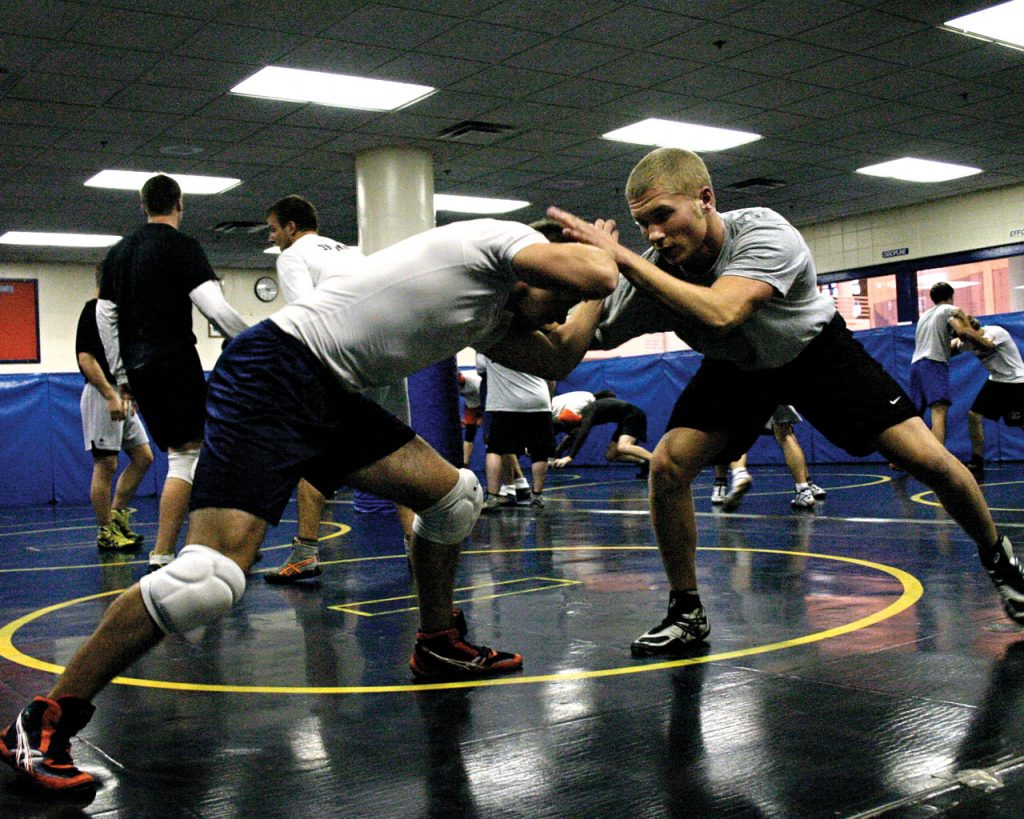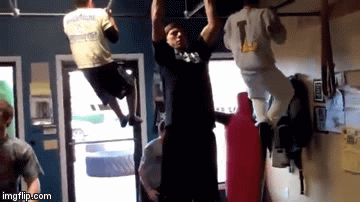
When it comes to which grapplers are the toughest out there, people usually do not think about Jiu-Jitsu athletes. Yes, there are some impressive specimens, but overall, the nerdy BJJ technicians dominate the scene. In a closely related grappling martial art though, the story is completely different. Wrestlers are known for their impressive physical shape and endless cardio. It’s not that wrestling is not technical, far from it. they just understand how important wrestling conditioning is and put a lot of emphasis on it. So, why not borrow something more than just takedowns fro the art of wrestling?
The reason why wrestling conditioning is so effective is due to time. After years of trial and error, those involved have come up with the perfect blueprint. Although it is not universal, most wrestling conditioning programs across the world are pretty similar. Another reason for this huge development in the area of wrestling conditioning is the fact that wrestling is an Olympic sport, meaning a lot is invested in reaching the top. Don’t get me wrong, Judokas are also amazingly conditioned athletes. Wrestlers, however, are years beyond even the most powerful Judokas, let alone BJJ players.
So, in terms of usefulness for Brazilian Jiu-Jitsu, is the wrestling conditioning approach a good fit? After all, the ruleset and character of both sports are somewhat different, meaning the physical requirements are not the same. Using takedowns as an example again, the important thing is to adopt what’s useful and discard the rest. Just like every takedown from wrestling doesn’t fit the needs of BJJ, wrestling conditioning shouldn’t be taken for granted. However, wrestlers have it down to a science and have a lot to offer us BJJ nerds in terms of conditioning.
A General Wrestling Conditioning Program
So, what is it take makes wrestling conditioning so different from the usual methods BJJ athletes choose to get in shape? First and foremost it is the intensity and frequency of work. Wrestlers train intensely and train very often. Granted, during a wrestling season they compete on a weekly basis meaning they need to be in shape constantly. In terms of BJJ there’s no need for such intensity and frequency. That said, if you’re cutting back do so on either intensity or frequency, not both.

Finally, specific programming of correct exercises with appropriate intensity and frequency brings everything together. In wrestling, every session has a strong conditioning component. Warmups are brutal, which is something that’s not really advisable for BJJ. However, hitting a circuit or some drills at the back end of class is perfect. Even better, you could go for separate conditioning sessions outside of class in order to up the intensity. So, let’s see how a solid wrestling conditioning plan looks like:
-
Movement Pattern Drills
A crucial factor in wrestling is athleticism. To develop overall athleticism, few things work better than developing gymnast-like coordination. The fact of the matter is you’re never going to reach gymnasts in terms of coordination but there’s no harm in trying. That said, this is where some of those drills you usually do in warm-ups come into play. Cartwheels, Rolls to handstand, handstand walks, sit outs and the like are the norms. Key moves like sprawls and penetration steps also make up a huge component of coordination drills. IN addition, doing them at a predetermined pace is going to jack up your heart rate as well, making you efficient at them even when tired.
2. Strength And Endurance Exercises

Pushups and pullup/chinup variations along with squat/lunge exercises and core training drills make up the bulk of the program here. However, instead of just banging out endless sets of pushups, wrestling conditioning is all about variety. They do virtually every kind of pushup there is, from regular to handstand pushups. Rope climbs are among pulling variations (for BJJ you could even throw in pullups with the Gi). Squats and lunges, as well as combo drills like burpees, complete the program. Explosive work can also be done here, without taxing the nervous system too much.
A huge aspect of bodyweight training emphasized in wrestling conditioning is neck and core work. The core is hit from all sides, not just working abs. Once again, gymnastic style exercises and isometric holds, in particular, are top choice drills. In terms of training the neck, nothing beats wrestling drills. From high rep supine contractions to bridge drill on the head, this is the best way to develop a choke-resistant neck.
3. Partner Drills
Finally, when it comes to working with external resistance, wrestlers have got things right. Although they employ traditional weight training, the best bang for the buck comes from working with partners. Since in both wrestling and BJJ we manipulate an opponent’s body weight during a match, you can see why this methodology beats traditional weightlifting.

If you’re thinking about improving your wrestling skills for Jiu-Jitsu we have the best resource for you. Why stop at wrestling when you can also throw in brutal submissions to tap your opponent? Enter Catch Wrestling and the best instructional on the subject to ever hit the market, Neil Melanson’s “Catch Wrestling Formula”. Everything a BJJ players needs to know about catch wrestling is in this amazing instructional.
Related Articles:
Bear Crawl Yourself Into Shape For Brazilian Jiu-Jitsu
33 BJJ Solo Grappling drills that will surely improve your game
Catch Wrestling vs BJJ and Which Art Has Better Submissions?
The Strength and Conditioning For BJJ Competitors
Jocko Willink: Pure Jiu-Jitser will beat Pure Wrestler 9 out of 10 times in a real fight!
BJJ Mobility Drills For Flexible Hips


![Darce Choke Encyclopedia – Origins, Mechanics and Variations [2025] BJJ, choke, Brabo, BJJ Darce Choke, D'arce Choke, Darce BJJ Choke](https://bjj-world.com/wp-content/uploads/2017/11/JungPoirierLeeYahoo-218x150.jpg)









![Slicin’ Calves Mikey Musumeci DVD Review [2025] Slicin' Calves Mikey Musumeci DVD Review](https://bjj-world.com/wp-content/uploads/2025/04/slicin-calves-mikey-musumeci-dvd-review-218x150.png)
![Jiu-Jitsu For Old Guys Guard Retention Bernardo Faria DVD Review [2025] Jiu-Jitsu For Old Guys Guard Retention Bernardo Faria DVD Review](https://bjj-world.com/wp-content/uploads/2025/03/old-guys-guard-retention-bernardo-faria-dvd-review-218x150.png)
![X-Guard Trickery Kyle Sleeman DVD Review [2025] X-Guard Trickery Kyle Sleeman DVD Review](https://bjj-world.com/wp-content/uploads/2025/03/x-guard-trickery-kyle-sleeman-dvd-review-218x150.png)
![Countering with Crab Ride Anthony Budion DVD Review [2025] Countering with Crab Ride Anthony Budion DVD Review](https://bjj-world.com/wp-content/uploads/2025/03/countering-with-crab-ride-anthony-budion-dvd-review-218x150.png)
![Closet Closed Guard Craig Jones DVD Review [2025] Closet Closed Guard Craig Jones DVD Review](https://bjj-world.com/wp-content/uploads/2025/03/closet-closed-guard-craig-jones-dvd-review-218x150.png)
![Xanadu Back Takes Levi Jones-Leary DVD Review [2025] Xanadu Back Takes Levi Jones-Leary DVD Review](https://bjj-world.com/wp-content/uploads/2025/03/xanadu-back-takes-levi-jones-leary-dvd-review-218x150.png)
![No-Gi Open Guard K-Guard Lachlan Giles DVD Review [2024] No-Gi Open Guard K-Guard Lachlan Giles DVD Review](https://bjj-world.com/wp-content/uploads/2024/12/no-gi-open-guard-k-guard-lachlan-giles-dvd-review-324x235.png)

![Darragh O’Conaill Crucifix Encyclopedia DVD Review [2024] Darragh O'Conaill Crucifix Encyclopedia DVD Review](https://bjj-world.com/wp-content/uploads/2024/10/darragh-oconaill-crucifix-encyclopedia-dvd-review-100x70.png)
![Woj Lock the World Chris Wojcik Ankle Locks DVD Review [2024] Woj Lock the World Chris Wojcik Ankle Locks DVD Review](https://bjj-world.com/wp-content/uploads/2024/12/woj-lock-the-world-chris-wojcik-dvd-review-100x70.png)
![The Stack Pass Andre Galvao DVD Review [2025] The Stack Pass Andre Galvao DVD Review](https://bjj-world.com/wp-content/uploads/2025/01/the-stack-pass-andre-galvao-dvd-review-100x70.png)

![Zen Guide To Submission Grappling Margot Ciccarelli DVD Review [2025] Zen Guide To Submission Grappling Margot Ciccarelli DVD Review](https://bjj-world.com/wp-content/uploads/2025/02/submission-grappling-margot-ciccarelli-dvd-preview-100x70.png)
![Bricks Kesa Gatame System Jeremy Brick DVD Review [2025] Bricks Kesa Gatame System Jeremy Brick DVD Review](https://bjj-world.com/wp-content/uploads/2025/02/bricks-kesa-gatame-system-jeremy-brick-dvd-review-100x70.png)
![Complete Front Headlock System Michael Pixley DVD Review [2024] Complete Front Headlock System Michael Pixley DVD Review](https://bjj-world.com/wp-content/uploads/2024/10/front-headlock-system-michael-pixley-dvd-review-100x70.png)

![Assassin Choke Baret Yoshida DVD Review [2024] Assassin Choke Baret Yoshida DVD Review](https://bjj-world.com/wp-content/uploads/2024/10/assassin-choke-baret-yoshida-dvd-review-100x70.png)


![Front Headlock and Turtle Escapes Brian Glick DVD Review [2024] Front Headlock and Turtle Escapes Brian Glick DVD Review](https://bjj-world.com/wp-content/uploads/2024/11/headlock-and-turtle-escapes-brian-glick-dvd-review-100x70.png)

![Dynamic Headquarters Passing Jason Rau DVD Review [2024] Dynamic Headquarters Passing Jason Rau DVD Review](https://bjj-world.com/wp-content/uploads/2024/10/dynamic-headquarters-passing-jason-rau-dvd-review-100x70.png)

![Reverse Arm Bar System Andrew Kerfoot DVD Review [2024] Reverse Arm Bar System Andrew Kerfoot DVD Review](https://bjj-world.com/wp-content/uploads/2024/10/reverse-arm-bar-system-andrew-kerfoot-dvd-review-100x70.png)

![Higher Tripod Passing Craig Jones DVD Review [2025] Higher Tripod Passing Craig Jones DVD Review](https://bjj-world.com/wp-content/uploads/2025/02/higher-tripod-passing-craig-jones-dvd-review-100x70.png)

![Unpinnable Mount Escape Mastery Haleem Syed DVD Review [2025] Mount Escape Mastery Haleem Syed DVD Review](https://bjj-world.com/wp-content/uploads/2025/01/mount-escape-mastery-haleem-syed-dvd-review-100x70.png)

![Top Half Guard Neil Melanson DVD Review [2025] Top Half Guard Neil Melanson DVD Review](https://bjj-world.com/wp-content/uploads/2025/02/top-half-guard-neil-melanson-dvd-review-100x70.png)

![Grappling Takedown Dominance Brandon Ruiz DVD Review [2025] Grappling Takedown Dominance Brandon Ruiz DVD Review](https://bjj-world.com/wp-content/uploads/2025/01/grappling-takedown-dominance-brandon-ruiz-dvd-review-100x70.png)

![Ginastica Natural Alvaro Romano DVD Review [2024] Ginastica Natural Alvaro Romano DVD Review](https://bjj-world.com/wp-content/uploads/2024/12/ginastica-natural-alvaro-romano-dvd-review-100x70.png)
![How to Double Leg Anyone Kevin Lee DVD Review [2024] How to Double Leg Anyone Kevin Lee DVD Review](https://bjj-world.com/wp-content/uploads/2024/11/how-to-double-leg-anyone-kevin-lee-dvd-review-100x70.png)
![Knee Lever John Wayne Sweep Adam Wardzinski DVD Review [2024] Knee Lever John Wayne Sweep Adam Wardzinski DVD Review](https://bjj-world.com/wp-content/uploads/2024/12/john-wayne-sweep-adam-wardzinski-dvd-review-100x70.png)